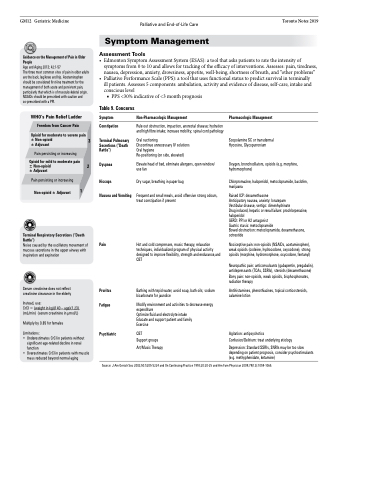Page 480 - TNFlipTest
P. 480
GM12 Geriatric Medicine
Guidance on the Management of Pain in Older People
Age and Aging 2013; 42:1-57
The three most common sites of pain in older adults are the back, leg/knee and hip. Acetaminophen should be considered first-line treatment for the management of both acute and persistent pain, particularly that which is of musculoskeletal origin. NSAIDs should be prescribed with caution and co-prescribed with a PPI.
Palliative and End-of-Life Care Toronto Notes 2019 Symptom Management
Assessment Tools
• EdmontonSymptomAssessmentSystem(ESAS):atoolthataskspatientstoratetheintensityof symptoms from 0 to 10 and allows for tracking of the efficacy of interventions. Assesses: pain, tiredness, nausea, depression, anxiety, drowsiness, appetite, well-being, shortness of breath, and “other problems”
• PalliativePerformanceScale(PPS):atoolthatusesfunctionalstatustopredictsurvivalinterminally ill patients. Assesses 5 components: ambulation, activity and evidence of disease, self-care, intake and conscious level
WHO’s Pain Relief Ladder Freedom from Cancer Pain
3
2
1
Table 9. Concerns
Symptom
Constipation
Terminal Pulmonary Secretions (“Death Rattle”)
Dyspnea
Hiccups
Nausea and Vomiting
Pain
Pruritus Fatigue
Psychiatric
Non-Pharmacologic Management
Rule out obstruction, impaction, anorectal disease; hydration and high fibre intake; increase mobility; spinal cord pathology
Oral suctioning
Discontinue unnecessary IV solutions Oral hygiene
Re-positioning (on side, elevated)
Elevate head of bed, eliminate allergens, open window/ use fan
Dry sugar, breathing in paper bag
Frequent and small meals, avoid offensive strong odours, treat constipation if present
Hot and cold compresses, music therapy, relaxation techniques, individualized program of physical activity designed to improve flexibility, strength and endurance,and CBT
Bathing with tepid water, avoid soap, bath oils; sodium bicarbonate for jaundice
Modify environment and activities to decrease energy expenditure
Optimize fluid and electrolyte intake
Educate and support patient and family
Exercise
CBT
Support groups
Art/Music Therapy
Pharmacologic Management
Scopolamine SC or transdermal Hycosine, Glycopurronium
Oxygen, bronchodilators, opioids (e.g. morphine, hydromorphone)
Chlorpromazine, haloperidol, metoclopramide, baclofen, marijuana
Raised ICP: dexamethasone
Anticipatory nausea, anxiety: lorazepam
Vestibular disease, vertigo: dimenhydrinate
Drug induced, hepatic or renal failure: prochlorperazine, haloperidol
GERD: PPI or H2 antagonist
Gastric stasis: metoclopramide
Bowel obstruction: metoclopramide, dexamethasone, octreotide
Nociceptive pain: non-opioids (NSAIDs, acetaminophen), weak opioids (codeine, hydrocodone, oxycodone), strong opioids (morphine, hydromorphone, oxycodone, fentanyl)
Neuropathic pain: anticonvulsants (gabapentin, pregabalin), antidepressants (TCAs, SSRIs), steroids (dexamethasone) Bony pain: non-opioids, weak opioids, bisphosphonates, radiation therapy
Antihistamines, phenothiazines, topical corticosteroids, calamine lotion
Agitation: antipsychotics Confusion/Delirium: treat underlying etiology
Depression: Standard SSRIs, SNRIs may be too slow depending on patient prognosis, consider psychostimulants (e.g. methyphenidate, ketamine)
■ PPS <30% indicative of <3 month prognosis
Opioid for moderate to severe pain ± Non-opioid
± Adjuvant
Pain persisting or increasing
Opioid for mild to moderate pain ± Non-opioid
± Adjuvant
Pain persisting or increasing
Non-opioid ± Adjuvant
Terminal Respiratory Secretions (“Death Rattle”)
Noise caused by the oscillatory movement of mucous secretions in the upper airway with inspiration and expiration
Serum creatinine does not reflect creatinine clearance in the elderly
Instead, use:
CrCI = (weight in kg)(140 – age)(1.23) (mL/min) (serumcreatinineinμmol/L)
Multiply by 0.85 for females
Limitations:
• Underestimates CrCl in patients without
significant age-related decline in renal
function
• Overestimates CrCl in patients with muscle
mass reduced beyond normal aging
Source: J Am Geriatr Soc 2002;50:S205-S224 and On Continuing Practice 1993;20:20-25 and Am Fam Physician 2009;79(12):1059-1065.


